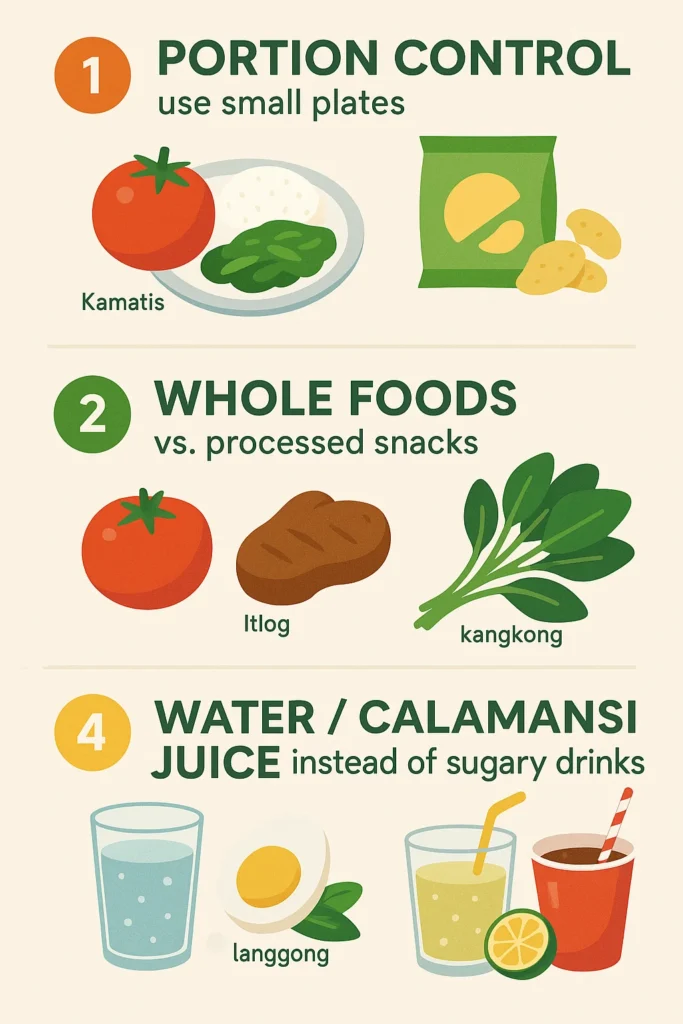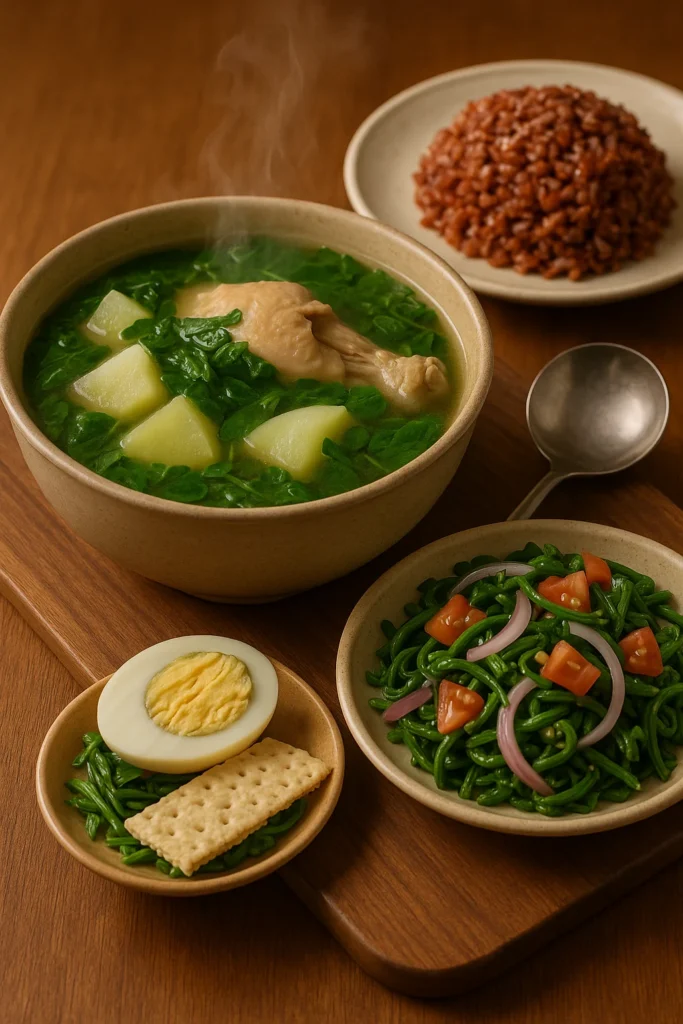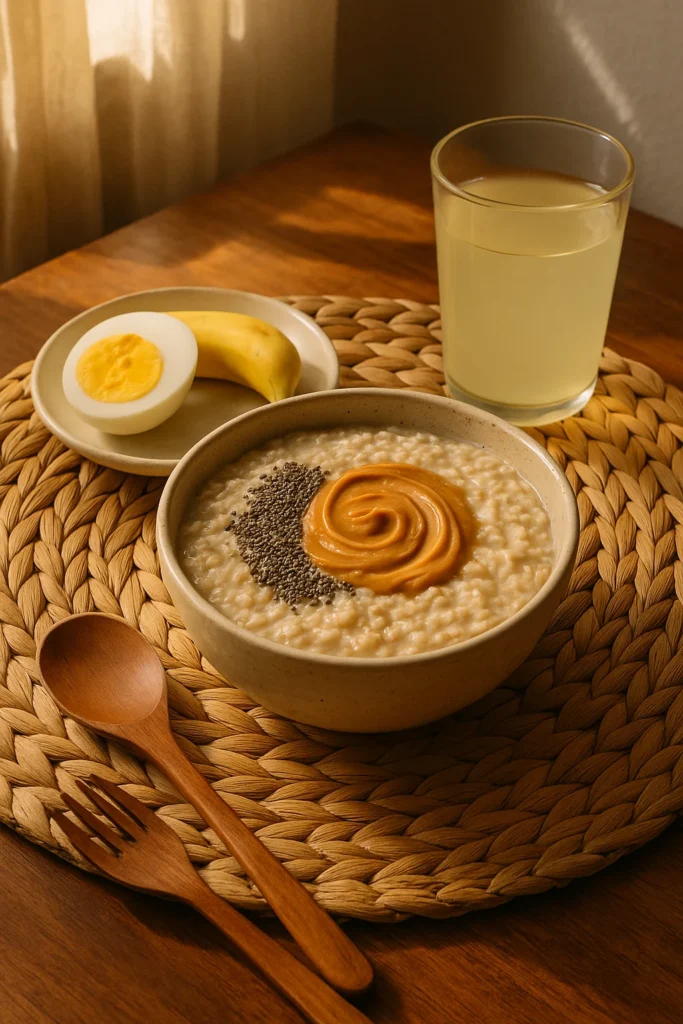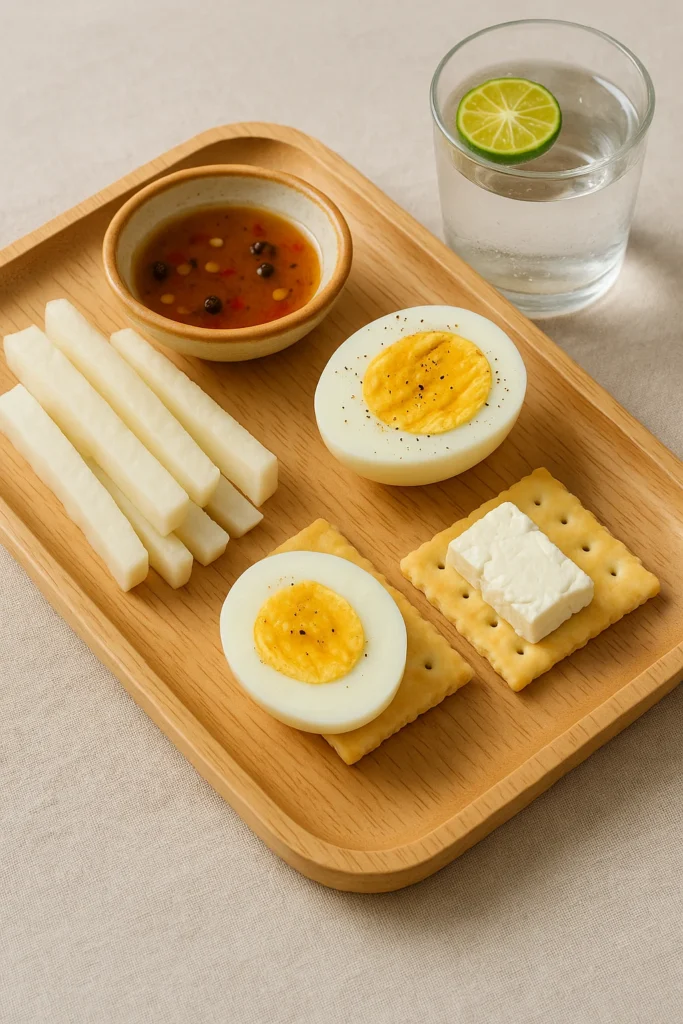Table of Contents
Your guide to simple, local, and blood-sugar-friendly Pinoy meals
“The Philippines now has over 4 million diagnosed diabetics — and that number keeps rising.” – Philippine Society of Endocrinology
Filipino diabetic meal plan — it sounds like something you’d see in a brochure or a clinic wall. But for our clients, it became real the day were diagnosed with Type 2 diabetes.
They didn’t panic — but they did pause. Every meal mattered now. They couldn’t just cook whatever was in the fridge. Suddenly, they had to think in terms of low sugar meals, portion control, and smart swaps — and still keep it delicious.
If you’re reading this, chances are someone you love (maybe even you) is going through the same thing. That’s why I want to share a real, doable Filipino diabetic meal plan, using ingredients you can find at your local market or grocery. No intimidating “superfoods” or foreign recipes. Just good, homegrown food that works.
What Makes a Filipino Diabetic Meal Plan Work?

Let’s be real — food is central to Filipino life. Every celebration, every weekend, every stressful moment is tied to what’s on the table. That’s why managing diabetes through diet hits close to home. It’s not just about nutrition; it’s about culture, tradition, and love.
A diabetes diet plan in the PH doesn’t mean cutting out rice completely or saying goodbye to all your favorite dishes. It means finding balance is more important now than ever. It’s about keeping your blood sugar steady — not spiking and crashing like EDSA traffic during rush hour.
For our clients, we always urge them to start small. No sudden bans. No shaming. Just quiet, steady changes.
Like what they can do with rice. At first, our clients were confused. They never imagined they could eat rice ever again. But after a week or two? They thank us because they never feel deprived.
We also help our clients start cooking more vegetables. But not plain ones. They can sautée eggplants with garlic. They turn upo into soup with ground chicken. They make chopsuey with less oil and lots of color. Our dining table started to look brighter.
Here’s what helped they say helped them the most:
- Choosing whole foods instead of processed. We encourage them to cut back on canned goods and quick-fry items. Fresh fish, chicken breast, eggs, tofu — these became staples. My client even started to enjoy tofu sisig!
- Watching portions. Especially rice. One trick we taught them to use? Smaller plates. It sounds like a joke, but when your plate is smaller, it looks full faster. You trick your brain into satisfaction.
- Adding more veggies and lean protein. Protein helps you stay full longer. So meals felt satisfying even with less rice. We’d encourage them to boil eggs, stir-fry kangkong, steam okra — and suddenly, plates felt complete.
- Swapping high-sugar drinks for water or buko juice (in moderation). Soft drinks were hard to let go of for most of them. So we made infused water with lemon or cucumber. They say it felt like a treat without the sugar crash.
Also — we made snacks part of the Filipino diabetic meal plan. Skipping meals led to overeating, which caused unnecessary sugar spikes. So we built in small, protein-rich snacks to help clients keep their blood sugar stable.
The beauty of a Filipino diabetic meal plan is that it doesn’t need to erase cultural comfort. A well-balanced Pinoy diabetic diet can still feature tinola, sinigang, and inihaw — as long as we’re mindful with portions and ingredients. You just learn to build the plate better. Add veggies. Limit rice. Choose lean meat. Adjust slowly.
So yes — it takes work. But not misery. Not if you approach it with care, creativity, and a dash of calamansi. With the right tweaks, the Filipino diabetic meal plan can feel less like a diet and more like a return to home-cooked simplicity — only smarter and healthier.
Sample Filipino Diabetic Meal Plan for the Day

This sample Filipino diabetic meal plan isn’t a one-size-fits-all. But it’s a great starting point. Here’s how it looks when broken down into a day:
Breakfast
- Oatmeal lugaw – This is one of our favorite diabetic meal plan breakfast staples to recommend. Use rolled oats and boil it down with water or unsweetened almond milk until it’s soft and creamy. Mix in a teaspoon of peanut butter and a sprinkle of chia seeds for extra fiber and protein. It feels indulgent, but it’s balanced and blood sugar-friendly.
- 1 boiled egg – Simple, easy, and packed with protein. It’s a constant in busy Filipino diabetic meal plan mornings because it helps with satiety.
- 1 banana (small lakatan) – Small enough not to spike sugar but satisfying enough to feel like a treat. Stick to small portions and always eat it with protein or fat.
Why it works: Oats are rich in soluble fiber, which helps regulate blood sugar. The egg provides healthy fat and protein that balances the meal. And the banana? It’s nature’s candy — but in the right amount. This trio works beautifully together in any Filipino diabetic meal plan.
Mid-Morning Snack
- Slices of cucumber and singkamas – Crisp, juicy, and hydrating.
- 1 glass of warm water with calamansi – It refreshes the body and aids digestion.
This snack is a breakthrough for most. We realized not every snack needs to be something fried or starchy. Sometimes crunch is enough. Keep a container of pre-cut singkamas in the fridge for easy grabs.
Lunch
- Grilled bangus belly – Seasoned simply with calamansi, pepper, and brushed with a bit of olive oil.
- 1/2 cup rice – Use unpolished rice or red rice sometimes for variety.
- Ginisang ampalaya with egg and tomatoes – No sugar, just lots of garlic, onion, and patience when cooking.
One trick we discovered is soaking the ampalaya slices in salt water for 10–15 minutes before cooking. It removes most of the bitterness without killing its nutrients. Even my niece, who’s 7, eats it now.
Afternoon Snack
- Hard-boiled egg or
- A small serving of lumpiang ubod (no sauce) – Preferably fresh, not fried.
The egg is a go-to because it’s filling and quick. But on days when you have a little more prep time, lumpiang ubod with fresh veggies and coconut strips wrapped in soft lumpia wrapper made for a satisfying treat. Just skip the sugary sauce and opt for vinegar dip.
Dinner
- Tinolang manok – We use chicken breast, skip the skin, and load it up with malunggay and sayote.
- 1/2 cup red rice – Heavier texture but keeps you full.
- Pako salad – Dressed with sukang tuba, chopped onions, and tomatoes.
Pro tip: Avoid sweetened sauces, soy-heavy dishes, and food that’s mostly fat. But you can keep the flavor — think herbs, spices, calamansi, suka.
Before Bed (if hungry)
- 1 piece low-sugar skyflakes – Just enough to keep late-night hunger away.
- Or a small piece of kesong puti – Creamy and local, made with carabao milk.
This part of the Filipino diabetic meal plan is crucial. Going to bed hungry can cause blood sugar to drop — or spike by morning after your breakfast. Most clients learned this the hard way.
We’re not aiming for restriction. We’re aiming for sustainability. And with a Filipino diabetic meal plan that actually uses local ingredients and celebrates our food culture, it’s possible to eat well, stay healthy, and still feel like you’re enjoying every bite.
If you’re building a plan for someone you love, start here. Adjust based on their preferences and medical needs. And remember — it’s not just about blood sugar. It’s about making meals feel safe, nourishing, and familiar.
Tips for Sticking to Your Filipino Diabetic Meal Plan

Let’s face it — any diet can feel like a chore if it’s done alone or if it completely removes the joy from food. That’s especially true with a Filipino diabetic meal plan. We love flavor. We love gatherings. We love rice! So if we want to make this work long-term, we have to build habits that fit into our real lives — not fight against them.
1. Eat with the family.
Don’t isolate the diabetic. Eating healthy shouldn’t feel like exile. Start preparing meals that everyone could enjoy, not just the person with diabetes. Tinola without chicken skin? Still delicious. Stir-fried kangkong with garlic? Everyone loves it. It will make them feel supported, not singled out. The Filipino diabetic meal plan became a family journey — not just their battle.
2. Keep the pantry ready.
When you’re hungry and there’s nothing healthy in sight, it’s easy to grab junk. So stock your kitchen with diabetic-friendly staples: brown rice, eggs, rolled oats, frozen malunggay, tofu, canned tuna in water, and lots of veggies. Even snacks were prepped — like peeled singkamas in containers and hard-boiled eggs in the fridge. A stocked pantry made sticking to the plan way easier.
3. Use small plates.
Clients didn’t think it would matter. But swapping regular dinner plates for smaller ones helped clients manage their portions without feeling deprived. The plate looked full — even if the rice was just half a cup. Portion control is one of the most underrated tips for sticking to a Filipino diabetic meal plan.
4. Make meals feel like home.
Don’t fall into the “diet food” trap. Bland grilled chicken and plain lettuce won’t work here. Filipinos need warmth, flavor, and food that feels comforting. Create healthy versions of your family favorites. For one client it was chicken adobo with less oil and served with veggies instead of fried sides. Season with vinegar, garlic, ginger, and calamansi — not sugar.
5. Plan cheat days — smartly.
Yes, this one might sound strange in a guide for diabetic meal planning. But we found that a controlled indulgence helped clients stay on track the rest of the week. On Sundays, they’d have just a small slice of leche flan or one piece of suman. No guilt. Just balance and it helped them commit to the plan.
6. Educate the whole household.
We encourage clients to read labels at the grocery store. Whenever they find new information they were curious about, we tell them to ask us if it’s actually valid. The more clients knew, the better they did. Everyone was part of the solution.
7. Celebrate the small wins.
Did you complete a full week without soda? Celebrate with halo-halo made with fruit and stevia. Did your sugar levels improve? Progress feels good when it’s shared.
Sticking to a Filipino diabetic meal plan isn’t about willpower alone. It’s about creating an environment where the healthy choice is also the easy one — and the enjoyable one.
It doesn’t have to be perfect. But it has to feel right.
One step at a time. One meal at a time. That’s how you can make it stick.
Filipino Diabetic Meals Can Be Low Sugar and Still Delicious

“Sugar is joy,” my client once said. And for many more Filipinos, that’s true. From halo-halo to leche flan, from sweet spaghetti to banana cue — sugar is woven into our comfort food. So when they started a Filipino diabetic meal plan, most of their biggest fear wasn’t needles. It was bland food.
That’s probably your fear, too — that you’d lose the joy of food. But guess what?
You won’t if you work with YOU%.
Instead, we help you discover something even better: flavor doesn’t have to come from sugar. It can come from the way you cook, season, combine, and respect local ingredients. Even simple dishes like ensaladang talong or sinigang na hipon (made with real sampalok, not mix packets) remind us that flavor is deeper than sweetness.
You will find ways to enjoy your favorite food without compromising the Filipino diabetic meal plan. One night, my client made ginataang kalabasa with shrimp — but skipped the sugar. She added malunggay for fiber and served it with a spoonful of red rice. My client’s eyes lit up. “Lasang probinsya!” she said. And that was it — proof that you can cook with heart, even when you’re cooking for health.
Here’s what worked for them (and will probably work for you too):
- Acids over sugar. Calamansi, suka, tomatoes — all added brightness to dishes without spiking blood sugar.
- Herbs and spices. Use fresh ginger, lemongrass, garlic, sili leaves, pandan, even curry leaves. It was still rich and creamy.
- Grilling and roasting. Grill eggplant, tilapia, or chicken with the skin removed, the smoky flavor was enough to elevate everything. Add a sawsawan of calamansi and pepper? Heaven.
- Texture and contrast. Crunchy singkamas with soft tofu. Sour sinigang with mellow talbos ng kamote. Variety made every meal interesting — even if it was a low sugar meal.
Desserts? Yes, our clients have those too — just in new ways. Make banana turon but air-fried it and used a sprinkle of cinnamon instead of sugar. Serve chilled taho without syrup but with added chia seeds. You can even make fruit salad with plain yogurt, bits of papaya and melon, and just one drop of honey.
The Filipino diabetic meal plan didn’t rob us of joy — it expanded our creativity. We were forced to think, taste, and invent. And honestly, we began enjoying meals even more. Because they were thoughtful. Intentional. Full of care.
If you’re nervous about starting a low sugar meal plan, especially within the context of Filipino food, take heart. There are endless ways to cook flavorful dishes that won’t mess with your blood sugar. Start with what you know. Add color. Use real ingredients. Taste often.
You don’t have to throw away everything you love. You just tweak. You adjust. And you learn.
And sometimes? You end up loving your meals more than ever.
You’re Not Alone on Your Filipino Diabetic Meal Plan Journey
Living with diabetes in the Philippines is hard — but not impossible. Start small. One meal at a time. One rice swap. One extra gulay.
For most clients trying to do a Filipino diabetic meal plan by themselves, it feels overwhelming. There is a lot of fear — fear of change, fear of making mistakes, fear of not doing enough. But with us, you can learn quickly that small steps make a big impact. You don’t need to master everything at once. You just need help to begin.
Of course, there will be days you get it wrong but those mistakes will teach you. You’ll get better. More confident. More aware.
Support makes all the difference. My clients started planning meals with the whole family instead of just for the person with diabetes. The Filipino diabetic meal plan became a family practice — not a solo mission. And that’s why it works.
If you’re caring for someone with diabetes, involve them in the process. Let them help cook. Let them taste and tweak. Give them some control back — because food isn’t just fuel. It’s emotional. Cultural. Human.
And if you’re building a full weekly meal plan, starting a health journey, or looking for diabetic Pinoy meals, we’d love to help. We, at YOU% Nutrition, help each client take control of their health and build long-term habits that will flow into your lifestyle.
For more health-related guides like this, check out this diabetes-friendly Filipino meal plan from the DOH. You can also explore helpful services through nutrition services in the Philippines or consult a dietitian in Cebu to build a Filipino diabetic meal plan that fits your lifestyle, taste, and health needs.



